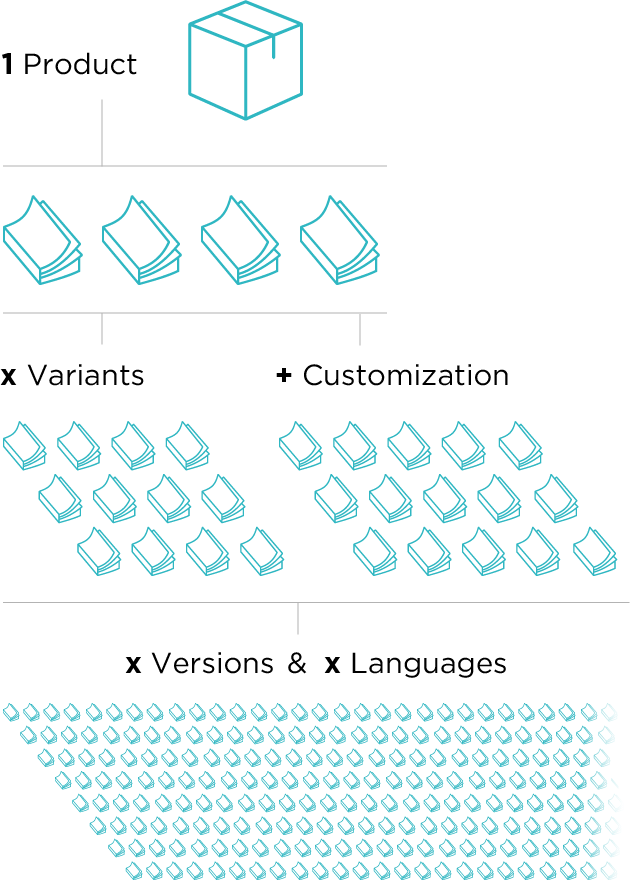By its very nature, tech doc is complex.
Producing accurate tech content requires aligning a lot of different elements. The information has to be exhaustive, the format needs to be relevant, and there’s juggling the contributors, editors, proofreaders, and publication process.
As a technical communications professional, you understand the complexities of the creation process – but your users? They care about the quality of the tech doc, they care about the product experience that your tech doc helps to power, but they don’t care about how hard it is to create that perfect technical documentation.
Your challenge is to deliver the rewarding experience that your users demand while managing the inherent complexities of the tech doc creation process. It’s a difficult task, but with the right technology choices you can transform complexity into clarity.
Tech Doc Isn’t Getting Any Simpler
Today’s tech doc is a lot of things, but one thing it isn’t is simple.
To begin with, tech doc is anything other than generic and needs to cover all the products that your company sells in every variant, configuration, customization, and version that exists. Every minor difference, update, or option needs to be covered along with every language or regional variation, too. The minor differences between product variants quickly add-up to additional technical content and just a single product might demand dozens, hundreds, or even thousands of versions of similar documents.
As well as the complexities of covering all of your products, your technical documentation is now being produced with different tools in a variety of formats that need to be integrated into a single documentation.
Simple word processing tools like Microsoft Word are sufficient for some content while other content demands specific editors or powerful authoring tools for modern structured writing. Markdown is used for some content, DITA for others, and video, audio, and 3D content demands more specialized creation tools. While certainly complicated and inherently complex, there’s no single creation tool that can handle all the different formats that are needed for technical documentation.
Add to all of this the sourcing for product documentation which is only expanding further. With industry preferences trending towards leveraging subject matter experts, the number of people involved in content creation for a single product, or even a single document, can be huge. There’s the product owner, the developers, and the engineers. There’s the technical writer, the product marketer, and the quality assurance team as well. No surprise, each of these teams prefer to use their own tool to create content so a diversity of contributors usually means a diversity of formats, too.
Finally, there’s the whole environment that tech doc is emerging into. Product life cycles are speeding up and, as long as legacy products need to be supported, tech doc teams must find ways to handle different generations of documentation, created with different generations of tools. The same complexity arises when documentation from OEMs, other vendors, or newly acquired companies needs integrating.
Put it all together and it’s clear: tech doc creation and maintenance is not simple, and it’s only getting more complicated. Yet despite these complications behind the scenes, tech doc can be delivered to users smoothly and without ever revealing the significant complexity behind every word.
Dynamic Delivery: Replace Complexity with Tech Doc that Just Works
Even as the complexity of tech doc creation continues to grow, the delivery of that tech doc to users can be a no-brainer. Thanks to modern Content Delivery Platforms (CDPs) technical content can be integrated from any number of sources and in any number of formats and delivered to a user faster, more efficiently, and more accurately than ever.
The Dynamic Delivery offered by a CDP allows for the ingestion of all tech doc content and the creation of a central, unified repository that represents a single source of truth for the end user. What used to be stored in different repositories or systems, and located after several unsuccessful attempts, is now accessible from a central place where anything they search can be found, no matter where, how, or by whom it was produced.
The advantages of a CDP for the business are both on the access and delivery sides. All content, unified in a single knowledge hub, can be delivered to the end user in the place and manner that best suit them. Be it a documentation portal, a community platform, a help-desk tool, or integrated into the product itself as in-product help, a CDP can feed all digital channels. Whether the user prefers to read the content on a laptop, a tablet, or a smartphone is no longer a problem either. The CDP adapts the content to the size of the device and makes images, videos, and other formats fit perfectly into the screen.
No matter the touchpoint, though, a CDP helps end users do the one thing that they want to do: find answers to the questions they have when they need those answers – and fast. Making tech doc available is one thing, but the complexities of tech doc means simply giving access to thousands of potential answers is no real help at all. Instead, powerful search engines backed with smart AI and natural language processing capacity can understand questions, context, and filter out the noise to deliver answers. CDPs that embed such search engines can point the user directly to the most relevant content quickly, simply, and with not a hint of the complex processes that are hidden from their view.
Complex to Produce, Easy to Consume
The creation of technical content is not getting any easier, for a variety of reasons. It’s complex, and while this complexity might be a daily challenge for technical content professionals, there’s no need for end users to face the same sort of complications when they access tech docs looking for answers.
A CDP makes even the most complicated or complex tech doc easy to access, search, and use. It encourages a self-service engagement that users prefer and offers the content experience that they expect. With powerful search engines understanding the context of every query and cutting through the noise to deliver the perfect response in milliseconds, even the most complicated tech doc can be delivered to end users with a simplicity that will surprise and delight.
Latest post






